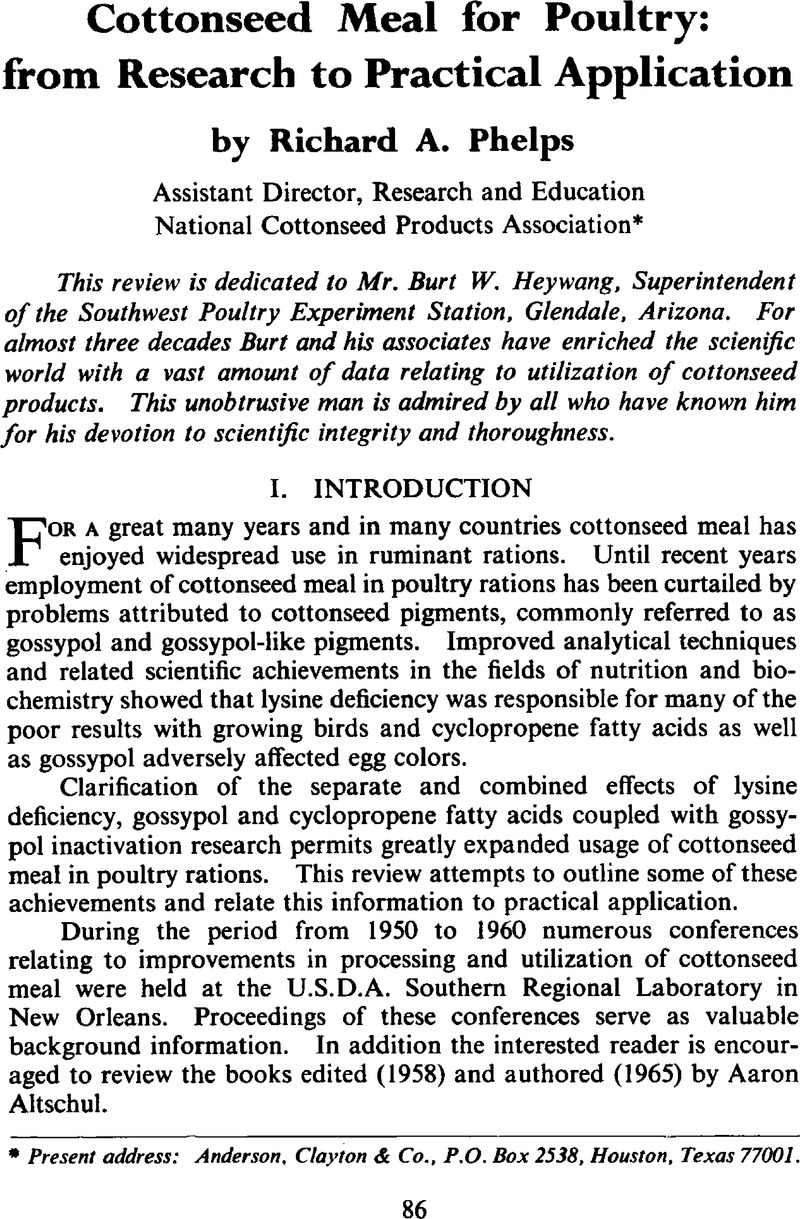Crossref Citations
This article has been cited by the following publications. This list is generated based on data provided by Crossref.
Waldroup, P.W.
Keyser, E.G.
Tollett, V.E.
and
Bowen, T.E.
1968.
The Evaluation of a Low-Gossypol Glandless Cottonseed Meal In Broiler Diets.
Poultry Science,
Vol. 47,
Issue. 4,
p.
1179.
Bressani, Ricardo
and
Elias, Luiz G.
1968.
Advances in Food Research Volume 16.
Vol. 16,
Issue. ,
p.
1.
Harper, Garlon A.
and
Smith, Keith J.
1968.
Status of cottonseed protein.
Economic Botany,
Vol. 22,
Issue. 1,
p.
63.
BERARDI, LEAH C.
and
GOLDBLATT, LEO A.
1969.
Toxic Constituents of Plant Foodstuffs.
p.
211.
Roberson, R.H.
1970.
A Comparison of Glandless Cottonseed Meal and Soybean Meal in Laying Diets Supplemented with Lysine and Methionine.
Poultry Science,
Vol. 49,
Issue. 6,
p.
1579.
Vohra, Pran
Hafez, Youssef
Earl, Leslie
and
Kratzer, F.H.
1975.
The Effect of Ammonia Treatment of Cottonseed Meal on Its Gossypol-Induced Discoloration of Egg Yolks.
Poultry Science,
Vol. 54,
Issue. 2,
p.
441.
Abou-Donia, Mohamed B.
1976.
Residue Reviews.
p.
125.
Galal, A. Gh.
Baker, D.H.
Norton, H.W.
and
Becker, D.E.
1977.
Evaluation of Supplemental Protein Sources for Broiler Chicks.
Poultry Science,
Vol. 56,
Issue. 2,
p.
703.
Salunkhe, D. K.
Wu, M. T.
and
Wood, G. E.
1977.
Toxicants in plants and plant products.
C R C Critical Reviews in Food Science and Nutrition,
Vol. 9,
Issue. 3,
p.
265.
Njike, M. C.
1978.
Cottonseed Meal as a Substitute for Groundnut Cake in the Diet of Baby Chicks.
East African Agricultural and Forestry Journal,
Vol. 44,
Issue. 1,
p.
59.
Sharma, N. K.
Lodhi, G. N.
and
Ichhponani, J. S.
1978.
Comparative feeding value of expeller-processed undecorticated and decorticated cottonseed cakes for growing chicks.
The Journal of Agricultural Science,
Vol. 91,
Issue. 3,
p.
531.
Waldroup, P. W.
Bussell, W. D.
and
Burke, A. B.
1980.
Lysine and Methionine Needs of Growing Egg-Type Pullets.
World's Poultry Science Journal,
Vol. 36,
Issue. 2,
p.
85.
REID, B.L.
GALAVIZ-MORENO, S.
and
MAIORINO, P.M.
1984.
A Comparison of Glandless and Regular Cottonseed Meals for Laying Hens.
Poultry Science,
Vol. 63,
Issue. 9,
p.
1803.
Braham, J. E.
and
Bressani, R.
1985.
Male Fertility and Its Regulation.
p.
135.
Johnson, L. A.
Farnsworth, J. T.
Sadek, N. Z.
Chamkasem, N.
Lusas, E. W.
and
Reid, B. L.
1986.
Pilot plant studies on extracting cottonseed with methylene chloride.
Journal of the American Oil Chemists' Society,
Vol. 63,
Issue. 5,
p.
647.
Papadopoulos, G.
and
Ziras, E.
1987.
Nutrient composition of Greek cottonseed meal.
Animal Feed Science and Technology,
Vol. 18,
Issue. 4,
p.
295.
REID, B.L.
GALAVIZ-MORENO, S.
and
MAIORINO, P.M.
1987.
Evaluation of Isopropanol-Extracted Cottonseed Meal for Laying Hens.
Poultry Science,
Vol. 66,
Issue. 1,
p.
82.
Hron, R. J.
Koltun, S. P.
Pominski, J.
and
Abraham, G.
1987.
The potential commercial aspects of gossypol.
Journal of the American Oil Chemists' Society,
Vol. 64,
Issue. 9,
p.
1315.
Yannakopoulos, A.L.
and
Tserveni-Gousi, A.S.
1989.
The effect of Greek cottonseed meal on the performance of laying Japanese quail.
Animal Feed Science and Technology,
Vol. 27,
Issue. 1-2,
p.
77.
Panigrahi, S.
Plumb, V. E.
and
Machin, D. H.
1989.
Effects of dietary cottonseed meal, with and without iron treatment, on laying hens.
British Poultry Science,
Vol. 30,
Issue. 3,
p.
641.



